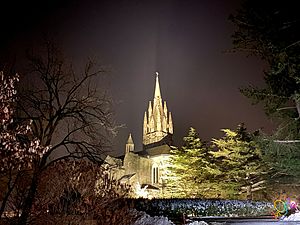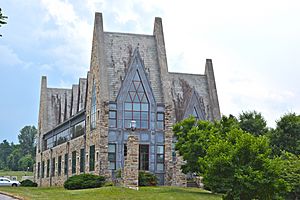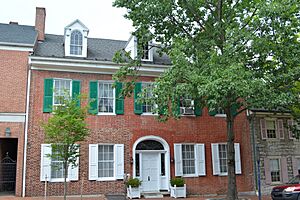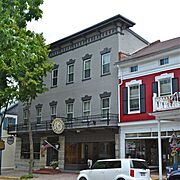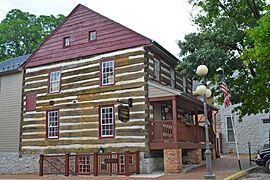Mercersburg, Pennsylvania facts for kids
Quick facts for kids
Mercersburg, Pennsylvania
|
|
|---|---|
|
Borough
|
|
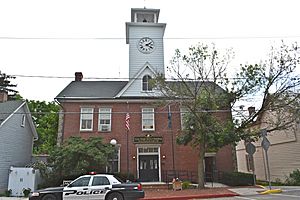
Mercersburg Borough Hall
|
|
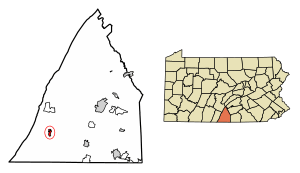
Location of Mercersburg in Franklin County, Pennsylvania.
|
|
| Country | United States |
| State | Pennsylvania |
| County | Franklin |
| Named for | Hugh Mercer |
| Government | |
| • Type | Borough Council |
| Area | |
| • Total | 0.90 sq mi (2.34 km2) |
| • Land | 0.90 sq mi (2.34 km2) |
| • Water | 0.00 sq mi (0.00 km2) |
| Elevation | 548 ft (167 m) |
| Population
(2020)
|
|
| • Total | 1,507 |
| • Density | 1,670.73/sq mi (645.12/km2) |
| Time zone | UTC-5 (Eastern (EST)) |
| • Summer (DST) | UTC-4 (EDT) |
| ZIP Code |
17236
|
| Area code(s) | 717 |
| FIPS code | 42-48704 |
| GNIS feature ID | 1215245 |
Mercersburg is a small town, called a borough, in Franklin County, Pennsylvania, United States. It is about 72 miles (116 km) southwest of Harrisburg, which is the capital city of Pennsylvania.
Because Mercersburg was in a rural area, many African Americans who had been enslaved found refuge here after the American Revolution. Pennsylvania had made slavery illegal. In the early 1800s, this area was even called "Black Town." People escaping slavery in the South also settled here, and the rural area nearby was known as "Little Africa."
Contents
Mercersburg's Story
Mercersburg was planned out in 1780. The town was named after Hugh Mercer, a brave general and hero from the American Revolutionary War. A post office has been open in Mercersburg since 1812.
Being close to Pennsylvania's southern border, Mercersburg became a safe place for African Americans who had escaped slavery in the South. Some arrived using the Underground Railroad, a secret network of safe houses and routes. After the American Revolution, Pennsylvania had ended slavery. This area had communities of free African Americans who worked on farms. It was easier for people seeking freedom to join these communities after crossing the border from Maryland.
This settlement was first known as "Black Town" before it officially became a borough in 1831. The countryside around the town was called "Little Africa" by local people. This was because many African Americans, including those who had escaped slavery, lived there.
Later, many African Americans moved away from Mercersburg. This was because they were in danger from slavecatchers, especially after the Fugitive Slave Act was passed in 1850. This law made it harder for free states to protect people who had escaped slavery. Many African Americans moved to Philadelphia, which had a large, free Black community. This community helped new arrivals settle down and find jobs.
Today, Mercersburg is still home to a diverse population. The Mercersburg Historic District, Lane House, and Mercersburg Academy are important historical sites listed on the National Register of Historic Places.
Where is Mercersburg?
Mercersburg is in the southwestern part of Franklin County. It covers about 0.9 square miles (2.3 square kilometers) of land.
The town is located at the eastern base of Cove Mountain. It sits on the west side of the Great Appalachian Valley. Mercersburg is about 7.5 miles (12.1 km) north of the Mason–Dixon line. This line marks the border between Pennsylvania and Maryland. The Whitetail Ski Resort and golf course are about 7 miles (11 km) south of town.
Several Pennsylvania state highways pass through Mercersburg. These include PA 16, PA 75, and PA 416. These roads connect Mercersburg to other towns like Greencastle, McConnellsburg, and Chambersburg.
Mercersburg's People
| Historical population | |||
|---|---|---|---|
| Census | Pop. | %± | |
| 1840 | 1,143 | — | |
| 1850 | 1,179 | 3.1% | |
| 1860 | 897 | −23.9% | |
| 1870 | 971 | 8.2% | |
| 1880 | 970 | −0.1% | |
| 1890 | 967 | −0.3% | |
| 1900 | 956 | −1.1% | |
| 1910 | 1,410 | 47.5% | |
| 1920 | 1,663 | 17.9% | |
| 1930 | 1,634 | −1.7% | |
| 1940 | 1,763 | 7.9% | |
| 1950 | 1,613 | −8.5% | |
| 1960 | 1,759 | 9.1% | |
| 1970 | 1,727 | −1.8% | |
| 1980 | 1,617 | −6.4% | |
| 1990 | 1,640 | 1.4% | |
| 2000 | 1,540 | −6.1% | |
| 2010 | 1,561 | 1.4% | |
| 2020 | 1,507 | −3.5% | |
| Sources: | |||
In 2020, about 1,507 people lived in Mercersburg. The town has a mix of different backgrounds. In 2000, about 92% of the people were White, and about 6.5% were African American. A small percentage of people were Asian or from other backgrounds. About 1.4% of the population was Hispanic or Latino.
The average household in Mercersburg had about 2 to 3 people. About 30% of households had children under 18 living there. The median age of people in the borough was 39 years old.
Learning in Mercersburg
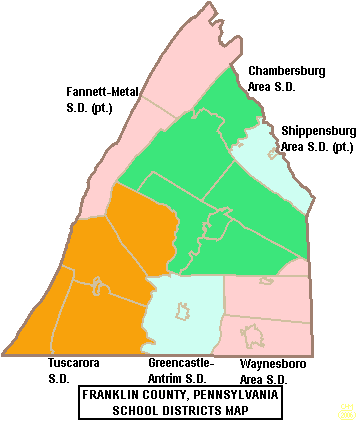
Tuscarora School District
The Tuscarora School District covers a large area of about 201 square miles (521 square kilometers). It includes Mercersburg and several nearby townships. This school district is mostly a rural area with farms. About 17,000 people live in the district.
The district has four elementary schools for students in kindergarten through 5th grade. It also has one middle school for grades 6-8, called James Buchanan Middle School. For high school, students attend James Buchanan High School (grades 9-12). The district's name, Tuscarora, comes from the Tuscarora Nation. This was an Iroquoian-speaking Native American tribe. They lived in this area for a while after moving from the Carolinas around 1713. They later moved north to New York and became the sixth nation of the powerful Iroquois League.
The local Delaware people, also known as Lenape, gave the name to Conococheague Creek. This creek flows through the district. In their language, Lenape, "Conococheague" means "clear water."
Mercersburg Academy
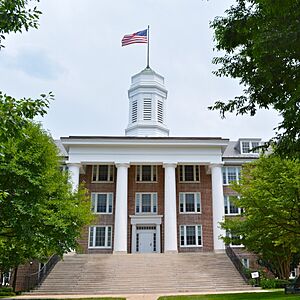
Mercersburg Academy is a special private school that helps students get ready for college. It was started in 1893. Many famous people have gone to Mercersburg Academy. These include people who won important scholarships (Rhodes scholars), military honors (Medal of Honor), and even a Nobel Prize winner. Two Academy Award winners and 54 Olympians (including 12 gold medalists) also attended the school. The school's campus is huge, covering 300 acres (1.2 km²) in downtown Mercersburg. It has about 430 students in grades 9-12, who come from many different states and countries.
Marshall College
Marshall College was founded in Mercersburg in 1836. Later, it joined with Franklin College. This new college is now in Lancaster County. Marshall College was known for something called the Mercersburg Theology. This was a special way of thinking about religion within the German Reformed Church.
Famous People from Mercersburg
- James Buchanan, who became the 15th President of the United States
- Jimmy Curran, an athlete and coach who trained five Olympic champions
- James Findlay, a former mayor of Cincinnati and U.S. Congressman
- John Findlay, a former U.S. Congressman
- William Findlay, a former Pennsylvania governor and U.S. Senator
- Henry Harbaugh, a clergyman who wrote in Pennsylvania Dutch
- Harriet Lane, the niece of President James Buchanan
- James S. McCullough, a former state auditor for Illinois
- Thomas Bard McFarland, a justice on the Supreme Court of California
- Joseph Mitchell, an Indiana Supreme Court justice, mayor of Goshen, Indiana, and a captain in the Civil War
- Blanche Nevin, a sculptor (someone who makes statues)
- John Williamson Nevin, a theologian (someone who studies religion)
- Benicio del Toro, a famous actor and producer
Images for kids
See also
 In Spanish: Mercersburg para niños
In Spanish: Mercersburg para niños




